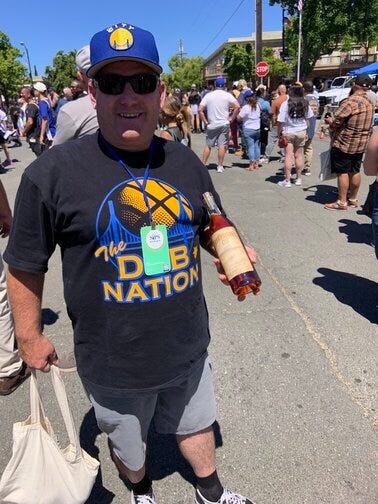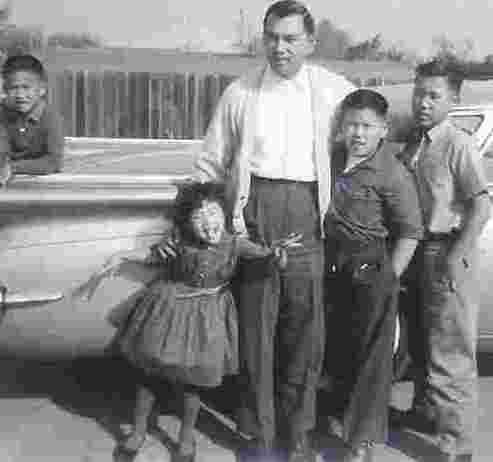Three Stories of America
Steph Curry in a Small Town, Kicking the Baseboard at East Hills Market, A New American Citizen
Greetings all, and thank you for honoring this space with your time.
We have three stories for you today, three little stories that make up the larger story of this grand, magnificently flawed country of ours. And what better way to start it off than with the greatest outside shooter of all time selling bourbon?
Big Man in a Small Town
The last three minutes of Saturday’s gold medal Olympic basketball game between France and the USA turned Steph Curry, for a brief time, into the most talked about person in the world. His shooting display that clinched the game for the Americans broke French hearts everywhere and brought joy to anyone who loves basketball and admires the excellence of athletic prowess of any kind.
Now, set the time machine back to June 29 and a place far away from the glamour of Paris: Benicia, California, the very definition of Small Town, USA. That was the day the great shooting guard of the Golden State Warriors came to this little city of 28,000 by the Carquinez Strait to promote a bourbon whisky, Gentleman’s Cut, that he is affiliated with.
The day was especially special for Benicia residents because it was Curry’s only promotional stop in the Bay Area. He lives in Atherton on the Peninsula. After Benicia he was flying off to train with Team America and play a series of practice games before the real ones began in France.
The town went a little ga-ga. The story appeared on the front page of the Benicia Herald. Everyone was talking about it, from the harbor up to the hills. It was the biggest thing to happen to the city since 1848 when a man in a Benicia general store broke the news that there had been a gold strike at Sutter’s Mill on the American River.
Hundreds of adoring Curry fans showed up that Saturday morning, many of them in Curry No. 30 jerseys and carrying pre-purchased bottles of Gentleman’s Cut for him to sign. On the scene were more local police, sheriffs, and private security than if the president had come to town.
“How’s everyone doin’? Real good? You chillin?” a private security guard asked while threading his way through the throngs gathered outside Sip’s, the First Street bottle shop that was hosting the event. Loudspeakers blaring hip hop and rap had been set up in the parking lot. There were a basketball hoop and putting green for those who wished to shoot hoops and practice their golf.
A big screen in the lot showed what was happening inside: The great man himself, sitting at a table, signing bottles of bourbon, and posing for selfies and pictures with fans.
The line of people hoping to visit with Curry in person stretched down First, turned left onto G Street, extended down to East 2nd, and snaked up that street for another block. One youthful entrepreneur was selling cold lemonade from an ice chest. At Elvia Rita’s Mexican place they were making enchiladas and tacos at a sidewalk stand.
People started showing up for Curry’s scheduled 10 a.m. appearance at six in the morning. Long-time Benicia resident Chris Core did not arrive that early, but he was all suited up and ready to go in his Dub Nation T-shirt and Golden State cap while toting that all-important pre-purchased bourbon bottle with an entry ticket guaranteeing an audience with his basketball hero.
“I’ve been a Warriors fan all my life,” said Core, explaining why he had come to the event. “I never thought we’d win a title in my era. Then this guy comes along and we’ve won four. I want to thank him.”
Core’s sentiments were no doubt shared by the millions of Americans who witnessed Curry’s gold medal performance.
Luisa Becomes An American
Another person with a glad and grateful heart is my Cuban-born friend Luisa, who has lived in this country five years on a permanent resident visa. I met her a few months ago and we get together every week to work on our language skills—hers in English, mine in Spanish. Meanwhile she has been studying hard to achieve a long-held dream of hers: American citizenship.
Test day took place Monday, August 5, and the night before she was an absolute nervous wreck. Unable to sleep much, she was up at 4 a.m. to review—for the millionth time—her studies.
Once her daughter picked her up they arrived at the testing site in Sacramento by 8:30, waiting for another two hours before the mother and grandmother entered the office, alone, where she was quizzed by a stern-faced examiner from the U.S. Citizenship and Immigration Services.
There were four parts to the exam. The first we explored in a previous Tilting West post, in which she had to answer questions about the country’s governance, history, and geography. The questions came from a list of 100 that she has been studying for months not knowing what they would ask on test day. She needed to get six of 10 questions correct in order to pass and when she nailed the first six posed to her flawlessly, the examiner halted that section of the test. There was no need to go on. She passed.
Parts two and three of the exam were equally perfect. In this section they were testing her reading and writing skills by dictating a question to her that she then had to write in longhand: What city is the White House in? Once she did that she had then to answer it verbally. “This was easy,” she told me.
Then came part four of the test: the personal questions. This was easily the longest and most comprehensive section of the test. The examiner really dug in here. All his questions, and all her answers, were in English.
Among the questions she was asked were: her name, address, how long she had lived at this address, date of birth, place of birth, marital status, when was the last time she left the country and for how long, had she ever voted in a U.S. federal election, ever registered to vote, ever been charged with or convicted of a felony, ever committed an act of violence against this country, did she pay income taxes, did she have a job, and so forth.
When speaking Spanglish with me Luisa laughs freely and often. But during the test she was concentrating so hard that she apparently barely smiled at all. Noting this, the examiner asked her how she felt.
“Good,” she replied.
“Are you happy?”
“Yes. I’m very happy.”
“Good,” said the examiner. “Because you passed. You are now a citizen of the United States of America.”
Luisa’s daughter was waiting in another room while the test was taking place, no doubt a bundle of nerves herself. When her mother appeared they shared hugs and tears of happiness. On the drive home Luisa excitedly called family members in Louisiana, Texas, and California, all of whom are American citizens. Like her now.
Next week in Sacramento she takes the loyalty oath to the United States at a naturalization ceremony for her and other newly-minted American citizens. Family and friends can attend, and if all goes as planned you should able to read about the celebration—una fiesta!—in a future Tilting West post.
Kicking the Baseboard at East Hills Market
A grocery store is more than just a place to buy food. It is where you meet and mingle with people, chat with the clerks, exchange gossip and news with friends you haven’t seen in a while. This is true now, and it was perhaps even more true in the 1960s and ‘70s when East Hills Market was in its flourishing prime. Two brothers, Joe and Eddie Jang, founded the Hayward, California market. Their parents emigrated from Guangzhou, China in the late 1800s and worked as farmers and merchants in the Delta region of Sacramento.
That was where Joe and Eddie were born and raised. Growing into manhood they and their three brothers fought in World War II and received Congressional medals for their service. After the war came a new chapter in their lives: marriage, children, and a move to the growing East Bay suburb of Hayward where they opened what would become a neighborhood institution.
We featured East Hills Market in a post a couple of months ago, and again in a discussion of hometowns a short time after that. But the old store continues to stir memories, starting with a note from former Hayward resident Jeff Brinkhaus who still remembers very well “the Jangs and East Hills Market, as well as the Schmidt's gas station. Lots of memories of passing that corner. Whether it was on foot, on my bicycle, or in my car I was either heading to a friend's house or up to East Avenue Park to shoot some hoops, play a little catch or hike down into the canyon that came out near the entrance to Woodland Estates.”
Another former Haywardite, Ray Melville, who now lives in Idaho, mentioned to me the other day how, as a teenager, he worked at East Hills with his older brother Dale and a neighborhood buddy, Gene Larson. One of their jobs was to sweep the muck and goo off the floor of the butcher shop. But the Jangs rewarded the three boys and all their employees with meals of corned beef sandwiches and other hearty fare. Gene respected Joe Jang so much that he attended his funeral.
The chat with Ray led to a text from Alan Jang, one of Joe’s sons, who grew up to be a successful attorney but got his first work experience as a boy at the family market. He too worked in the butcher shop where he learned how to cut up a whole chicken and had some fun doing other things, too.
“Like a lot of old-fashioned butcher shops,” Alan explains, “we bought bags of sawdust to keep us from slipping on the blood and fat that would fall on the floor during meat cutting. It was a nasty job to have to sweep up the sawdust, so we would all rotate cleaning up.
“One of the traditions in the butcher shop, started by our two older Portuguese butchers, was that they would kick the baseboard of the refrigerated butcher case whenever they saw a pretty girl on the other side. Then all of the stockroom boys would come out to take a look. That kick on the baseboard was meant to imitate the hoof of a stud horse getting ready, so if you heard a loud bang, you would know the girl was pretty hot.”
Since the market had generated such interest, recently I took a spin up into the hills of Hayward to see what it looked like today. It’s nothing like what it was, of course. The Jangs sold it long ago. It’s now called Bayhill Foods and it’s more of a convenience mart than a full-service grocery store. There’s no trace of sawdust or meat cutting anywhere to be found. It sells packaged food items and alcohol including, I would expect, Gentleman’s Cut bourbon.
The afternoon I was there two men were working the store. They shared a family resemblance and the way they interacted suggested that this was more than a standard boss-employee relationship. One was older—the father, perhaps. The other was a grown man but much younger—his son. They were of Middle East descent. Both spoke English but the old man’s voice carried an accent.
I almost certainly could have found out more—who they were for certain and their positions at the store. Most people, I’ve found, are fairly open if you present yourself in a friendly way and explain who you are. But for whatever reason a bout of shyness overcame me and I kept my questions to myself. This was, in basketball terms, an air ball on my part, a total miss.
Thinking about it later, it occurred to me that like the Jangs and Luisa and Steph Curry, both men belonged to a family. It may be that the son now had children of his own and Dad was a grandpa. Though their roots clearly originated in another land, here they were, possibly taking a huge risk in an investment in their new country. It seemed they, too, were writing their own American Dream story. Long may they, and all of us, thrive.









I truly enjoyed all three short pieces in this week’s edition. I always resonate with your stories about the Hayward in which you grew up, because I also grew up in a small town. The story about East Hills Market brought back memories of the local market and butcher shop where my mom always bought our meet. Thanks, Kevin!